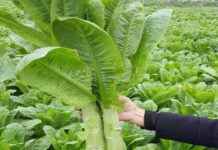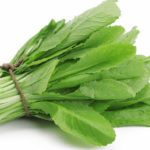With the cool weather of September approaching, many families are looking for easy-to-grow seasonal vegetables to ensure healthier and safer meals. Growing vegetables according to the season will also ensure better development, fewer pests, and higher yields. So, what are the best vegetables to plant during this time that will provide an abundant harvest with minimal effort? Let’s find out!
1 Cabbage
 Cabbage
Cabbage
Cabbage is a cold-hardy vegetable commonly grown in the highlands of Tay Nguyen, the North, and the Central regions of Vietnam. The early season for cabbage usually starts in September, with a harvest period from November to December. Cabbage is a versatile vegetable that can be enjoyed raw, boiled, stir-fried, or even dipped in fish sauce.
Choose a loamy, well-drained soil and plant the seeds in a container. Soak the seeds in warm water for about half an hour before planting. Maintain adequate spacing between seeds, as the plants will need room to spread their leaves as they grow. Once the cabbage heads start forming, you can intercrop with small lettuce plants.
Supplement the soil with nitrogen and potassium fertilizers, or opt for organic farming by using diluted urine to promote cleaner growth. Water the plants twice a day, in the morning and evening, with just enough water. After 80 to 90 days of planting, you can harvest the cabbage and enjoy the fruits of your labor!
2 Carrots
 Carrots
Carrots
Carrots are an easy and inexpensive crop to grow. While their main season is from August to February, they are often planted in September. You can use buckets, plastic bags, or pots with drainage holes to plant carrots.
For the soil, use a mixture of coconut fiber and compost to ensure sufficient nutrients. When planting the seeds, maintain a distance of 5-7 cm between each seed, cover them with a thin layer of soil, and water them daily in the early morning to promote germination.
Carrots thrive in sunny conditions, so place your containers in a sunny spot, but avoid excessive heat. Regularly water your carrots, but be careful not to overwater, as this can lead to waterlogging. Use NPK fertilizer along with worm castings to promote healthy root growth. Once the carrots start forming, use soil to cover the roots, ensuring they remain hidden from sunlight. After three months, your carrots will be ready for harvest!
3 Turnips
 Turnips
Turnips
Turnips are a nutritious addition to any meal, packed with vitamins and minerals. Growing turnips at home is simple and requires minimal care. The main season for turnips is from September to late October, ensuring the sweetest and plumpest roots.
Choose a sunny and breezy location for planting. You can use buckets, pots, or containers on your rooftop garden. For the soil, select a sandy loam or light loam soil with good drainage. Before planting, soak the seeds in water for about 15 minutes to soften them.
To promote lush growth and larger roots, supplement the soil with NPK fertilizer and a weekly dose of diluted urea from the seedling stage until a week before harvest. Regularly inspect the leaves for pests and spray with insecticides as needed. Turnips are typically ready for harvest 75 to 80 days after planting.
4 Lettuce
 Lettuce
Lettuce
Lettuce is a nutrient-rich vegetable, packed with vitamins and minerals that boost immunity and aid digestion. It can be grown year-round, with the main season lasting from August to April. The cycle from seed to harvest is approximately 35 to 40 days. To grow lettuce at home, choose a container with a minimum size of 40×60 cm and place it in a sunny and breezy spot.
Lettuce seeds have a thin coat, so they can be sown directly into the soil without prior soaking. Lightly water the seeds and place the container in a shaded area to promote germination. For continuous growth, water the plants twice a day, reducing the frequency during the rainy season. Once the lettuce has two pairs of leaves, you can either pull them out to consume or replant them elsewhere. When the leaves are fully grown, gently twist and pull the leaves from the base for harvest, avoiding rough handling that may damage the plant.
5 Green Mustard
 Green Mustard
Green Mustard
Green mustard is a popular choice for home gardens due to its ease of cultivation and health benefits. It is rich in vitamins A and K, as well as minerals like calcium and iron. Here are some tips to help you grow a lush crop of green mustard:
Select a well-drained, airy soil rich in organic matter, or purchase ready-to-use soil from seed shops. After purchasing the seeds, soak them in warm water for about an hour, then incubate them for a day to increase the germination rate. Water the seeds twice a day, in the morning and evening, directly at the roots to promote root growth. After 30 to 40 days, your green mustard will be ready for harvest and culinary delights!
6 Choy Sum
 Choy Sum
Choy Sum
Choy sum, also known as Chinese flowering cabbage, offers a plethora of health benefits, including improved bone health, reduced inflammation, and better digestion. This Asian vegetable is a favorite among European and American chefs. Choy sum can be grown year-round, but the best results are achieved when seeds are sown during the spring-summer (March) or autumn-winter (September) seasons.
Select a loamy or sandy loam soil rich in nutrients, with a pH between 5.5 and 6.5. Before planting, sterilize the soil and apply base fertilizer to eliminate any pathogens. Soak the seeds in warm water for 3-4 hours, then drain and incubate before sowing. Plant 4-6 seeds per container. During the initial stages, the seedlings require ample water, so water them twice a day until they establish roots. After 30-35 days, your choy sum will be ready to harvest and add a delicious touch to your dishes!
7 Cauliflower
 Cauliflower
Cauliflower
Cauliflower thrives in cool weather and is mainly grown in the northern and central highlands regions of Vietnam. The main season is from September to October, yielding the sweetest and most flavorful heads. Growing cauliflower is not difficult, but there are a few key considerations:
Select a soil rich in organic matter and humus, with a pH between 6.5 and 6.8. Plant in an area with ample sunlight and good ventilation. Soak the seeds in warm water for 25-30 minutes to eliminate any potential pests, then sow them and water twice a day to maintain moisture for germination. Cauliflower takes about 75-80 days to mature and be ready for harvest.
8 Dill
 Dill
Dill
Dill has a distinctive aroma and is commonly used to enhance the flavor of seafood dishes while also reducing their fishy odor. Additionally, dill offers various health benefits, including pain relief, improved digestion, and increased lactation in nursing mothers.
After purchasing the seeds, dry them in the sun and leave them overnight before sowing. Due to their small and delicate nature, prepare the soil by leveling it and applying base fertilizer or manure to ensure sufficient nutrients. Regularly water the plants and apply fertilizer to promote faster growth. You can also use diluted urine to water the plants. After two months, your dill will be ready for harvest and culinary use!
9 Kale
 Kale
Kale
Kale thrives in cool weather and is typically grown from July to March. The ideal temperature for growing kale is around 21°C, and it can be cultivated in areas where temperatures do not exceed 30°C.
Before planting, soak the seeds in warm water for 2-5 hours to ensure a higher germination rate. Maintain a distance of 15 cm between each seed, and provide adequate moisture to promote healthy growth. Water the plants only when the soil feels dry. To prevent pests, spread a layer of dry grass around the base of the plants. Kale takes about 70-95 days to mature from seed to harvest.
10 White Radish
 White Radish
White Radish
White radish can be grown year-round, but for the best results, plant during the main season from August to September, when the roots will be larger and juicier. Select a sandy loam, loamy, or airy soil to ensure proper drainage. You can use containers or trays with a minimum height of 20 cm to provide sufficient space for the roots to develop.
Soak the seeds for 3-5 hours, then incubate them until they crack to increase the germination rate. When planting, maintain a distance of 5-10 cm between seeds, cover them with a thin layer of soil, and water to keep the soil moist. Water the plants once or twice a day. White radishes will be ready for harvest after 45-50 days. Avoid leaving them in the ground for too long, as the roots may become spongy.
These are our suggested vegetables to plant during September. We hope you can choose the right ones for your garden and enjoy a bountiful harvest during the cool autumn weather!
Which Color Cabbage Should You Buy: Green or White?
Are you considering adding cabbage to your grocery list? If so, you may be wondering which type of cabbage is more nutritious and tasty. In this article, we will dive into the differences between white and green cabbage to help you decide which one is best for you.
Recipe for Creating a Bright, Radiant Glow with Aloe Vera Gel and Carrots
 Carrots‘>
Carrots‘>Unlock the natural beauty potential of aloe vera and carrots with this simple recipe for a moisturizing and skin brightening whitening cream. Tap into the power of these two ingredients to achieve radiant skin without harsh chemicals!






































